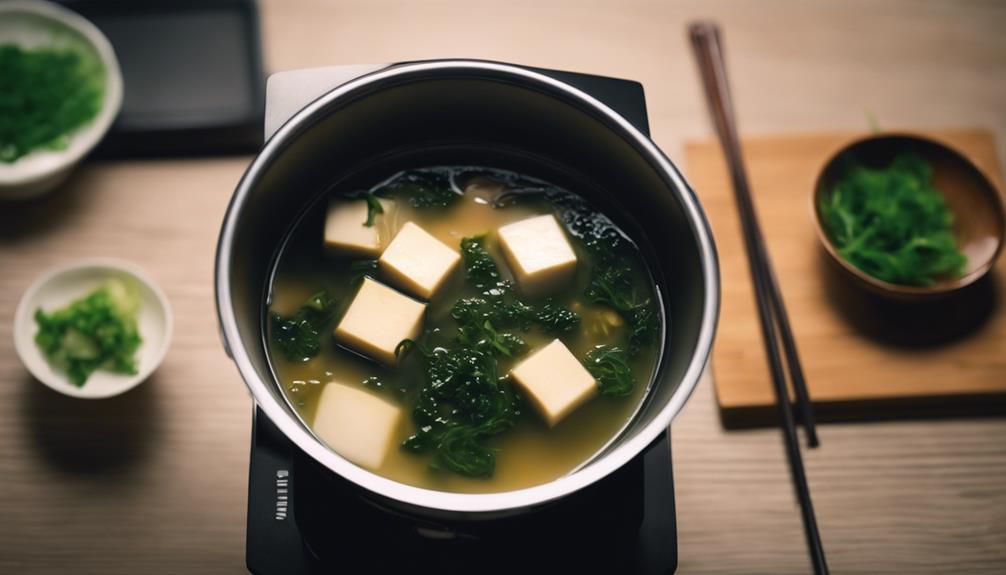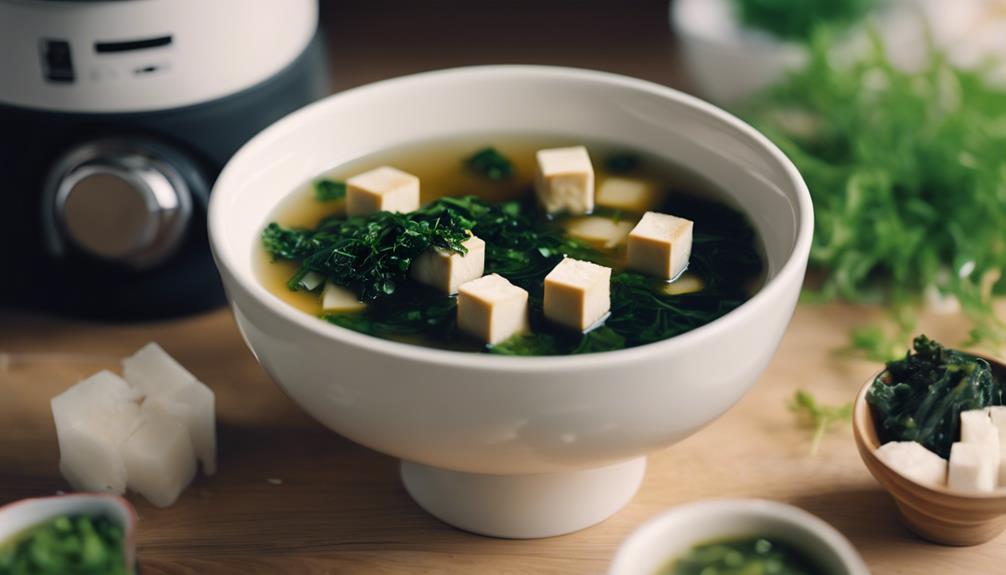Sous Vide Miso Soup With Tofu and Wakame
Indulge in a modern twist on classic miso soup! Using sous vide, enjoy enhanced flavors of tofu and wakame in every spoonful. This method guarantees a burst of umami with perfect texture and consistency. Elevate your dining experience with miso's rich nutrients and comforting warmth. Discover how sous vide takes this traditional dish to new heights, bringing a harmonious balance of flavors. Find out how innovative cooking techniques create a delicious and nourishing bowl that satisfies your cravings. Ready to savor a modern flavor adventure with sous vide miso soup?
What You Will Learn Here
- Sous vide cooking intensifies flavors of tofu and wakame.
- Precise temperature control ensures perfect flavor infusion.
- Delicate textures of ingredients are preserved using sous vide.
- Modern approach enhances traditional miso soup flavors.
- Consistently delivers a harmonious and delicious miso soup experience.
Origins of Miso Soup

So, let's talk about the origins of miso soup.
This beloved Japanese dish has a rich history and is deeply rooted in Japanese culinary traditions.
Understanding the ingredients, the traditional preparation of miso, and the health benefits it offers can provide valuable insights into why miso soup is cherished by many.
Miso Soup Ingredients
Originally crafted in Japan, miso soup has become a quintessential dish in Japanese cuisine. It boasts a blend of key ingredients like miso paste, tofu, and wakame.
Miso paste, derived from fermented soybeans, adds a deep umami taste to the soup, enhancing its flavor profile. Tofu, a protein-rich ingredient, contributes a soft and velvety texture to the dish, making it a satisfying addition.
Wakame, a type of seaweed, introduces a mild and unique flavor while providing a delightful chewy texture. When combined, these ingredients create a harmonious balance of flavors and textures that have made miso soup a beloved and comforting staple in Japanese culinary traditions.
Traditional Miso Preparation
In the traditional preparation of miso soup, the artful combination of miso paste, tofu, seaweed, and dashi stock forms the foundation of this iconic Japanese dish.
Miso paste, a key ingredient, is crafted from fermented soybeans, salt, and sometimes rice or barley. The savory and umami-rich flavor of miso enhances the overall taste profile of the soup.
Tofu, a protein-packed ingredient, adds a soft and creamy texture to the dish, balancing the flavors of the miso and seaweed.
When combined with the savory dashi stock, which is typically made from kombu and bonito flakes, the result is a harmonious blend of flavors that have been enjoyed for generations in Japan.
Health Benefits of Miso
To explore the origins of miso soup and its related health advantages, immerse into the rich history of this traditional Japanese seasoning.
White miso, a milder and slightly sweet variety of miso, is often used in miso soup preparations. This type of miso is fermented for a shorter period, retaining more of its natural enzymes and probiotics.
Soft tofu, commonly found in miso soup recipes, adds a creamy texture and plant-based protein to the dish. The health benefits of miso include being a good source of essential nutrients like vitamins B, E, and K, as well as minerals such as zinc, copper, and manganese.
Incorporating miso soup into your diet can support gut health, provide antioxidants, and offer a comforting, low-calorie option for a balanced meal.
Miso Paste Varieties

When exploring miso paste varieties for your culinary creations, it's essential to understand the distinct flavor profiles offered by white miso, red miso, and mixed miso blends.
- White Miso: Known for its mild and sweet flavor, white miso is a versatile option for adding a subtle umami taste to your dishes. It works well in lighter soups and dressings, enhancing flavors without overpowering other ingredients.
- Red Miso: With a richer and more intense taste, red miso adds depth and complexity to dishes like hearty stews and robust marinades. Its bold flavor can stand up well to stronger ingredients, making it a popular choice for savory soups.
- Mixed Miso Blends: Offering a balanced flavor profile, mixed miso blends combine the best of both worlds, creating a harmonious blend of sweet and savory notes. These blends are perfect for experimenting with different nuances in dishes like miso soup with tofu and wakame.
Understanding the unique characteristics of each miso paste variety allows you to elevate the taste of your soups and other dishes, creating a delightful culinary experience for yourself and those you serve.
Delicious Tofu Miso Soup Variations
Looking to elevate your tofu miso soup game?
Why not try a wakame-infused miso soup for a taste of the sea, or experiment with a soy-marinated tofu miso soup for a flavorful twist.
If you're feeling adventurous, a savory miso broth variant could add depth and complexity to your traditional tofu miso soup – the possibilities are endless!
Wakame-infused Miso Soup
Incorporating wakame seaweed into your miso soup enhances its depth of flavor and introduces a delightful oceanic essence to the traditional dish. Here are three reasons why you'll love wakame-infused miso soup:
- Umami-Rich Flavors: The combination of miso, tofu, and wakame seaweed creates a symphony of savory, salty, and slightly sweet flavors that dance on your taste buds.
- Unique Texture: The addition of wakame seaweed brings a unique texture to the soup, adding a pleasant chewiness that complements the softness of the tofu.
- Nutritious and Satisfying: With the nutritious benefits of tofu and the oceanic essence of wakame, this miso soup variation offers a wholesome and fulfilling meal option that will leave you feeling nourished and satisfied.
Soy-marinated Tofu Miso Soup
Enhance your traditional miso soup experience with the flavorful twist of soy-marinated tofu in this delicious variation. When preparing miso soup with tofu, consider marinating the tofu in soy sauce to elevate its taste and add complexity to the dish.
Here's how you can make the most of this soy-marinated tofu miso soup:
- Marinate the tofu: Infuse the tofu with soy sauce to enhance its flavor and create a savory profile that pairs perfectly with the miso broth.
- Complement the umami: The soy-marinated tofu adds depth to the umami-rich miso broth, creating a harmonious blend of flavors in each spoonful.
- Enjoy a unique twist: This variation offers a delightful departure from the traditional miso soup, adding a new dimension to your dining experience.
Savory Miso Broth Variant
To deepen the savory profile of your traditional miso soup, consider incorporating a rich miso broth variant that enhances the flavors of tofu and wakame while maintaining a nutritional balance. When enhancing your miso soup, try the following:
- Quality Miso Paste: Opt for high-quality miso paste to guarantee a rich and authentic flavor in your broth.
- Vegetable Broth Base: Using a vegetable broth base instead of water adds depth and complexity to the miso soup.
- Balanced Seasoning: Ensure a well-balanced seasoning by tasting as you go and adjusting the saltiness and sweetness levels to your preference.
Enhancing Umami Flavor Profile
To enhance the umami flavor profile in your miso soup, understanding the fundamentals of umami flavor is essential.
Pairing ingredients like miso, wakame, and tofu strategically can amplify the savory taste in your dish.
Utilizing specific cooking techniques, such as sous vide, can help intensify and balance the umami flavors, creating a rich and satisfying culinary experience.
Umami Flavor Basics
Explore the world of umami flavor basics, where savory richness and complexity elevate your culinary creations to new levels of taste satisfaction.
Umami, the fifth basic taste, can be enhanced by using ingredients like miso paste, soy sauce, seaweed, and mushrooms, known for their deep and satisfying flavor profiles.
When making dishes like a bowl of miso soup, incorporating umami-rich elements such as kombu (kelp) and bonito flakes can add depth and enhance the overall taste experience.
Umami taste receptors on the tongue respond to amino acids like glutamate, commonly found in miso, contributing to that savory sensation.
Techniques such as slow cooking and fermentation can also help intensify the umami flavor in dishes, making them even more delicious and satisfying.
Ingredient Pairing Tips
Enhancing the umami flavor profile can be achieved through strategic ingredient pairing tips that elevate the taste experience of dishes like miso soup. When preparing miso soup, consider the dynamic duo of miso and tofu. The umami-rich miso, with its fermented depth, combines harmoniously with tofu, a neutral protein sponge that absorbs flavors.
Adding wakame to this mix introduces a savory and slightly sweet note, further enhancing the umami profile of the dish. The trio not only creates a well-balanced flavor but also boosts the nutritional value of the soup, providing essential amino acids and minerals.
Cooking Techniques for Umami
For a delectable umami-rich experience in your miso soup, consider incorporating sous vide cooking techniques to enhance the flavors of tofu and wakame while preserving their delicate textures.
Sous vide cooking, a method that involves vacuum-sealing ingredients and cooking them in a water bath at a precise temperature, is perfect for infusing tofu and wakame with rich umami flavors without guaranteeing their tenderness.
The controlled environment of sous vide guarantees that the miso soup develops a perfect consistency and depth of flavor, avoiding any risk of scorching or uneven cooking.
Final Thoughts
In reflecting on the sous vide miso soup with tofu and wakame, consider how this innovative cooking method enhances the traditional flavors and textures of this classic dish.
By incorporating the tofu into the miso soup using the sous vide technique, you guarantee that the tofu maintains its delicate texture, and the wakame seaweed rehydrates evenly, providing a perfect balance of softness and chewiness in every bite.
The precise temperature control of sous vide cooking allows the flavors in the miso soup to fully infuse as all the ingredients cook together in a sealed bag, resulting in a harmonious blend of umami-rich tastes.
This modern cooking approach enriches the overall experience of miso soup by intensifying the flavors of miso, tofu, and wakame. The outcome is a consistently delicious and comforting bowl of miso soup that's sure to satisfy your cravings for a warm and nourishing meal.
Frequently Asked Questions
Can I Use Wakame Instead of Kombu in Miso Soup?
Yes, you can use wakame instead of kombu in miso soup. Wakame offers a different texture and flavor, adding a slightly sweet and briny taste while being rich in essential nutrients. It enhances the umami profile and provides a lighter, delicate flavor.
Do You Have to Drain Tofu for Miso Soup?
You don't have to drain tofu for miso soup. The tofu's texture is minimally impacted, and it absorbs flavors well as is. Skip the draining step to simplify your cooking process and still enjoy a delicious soup.
Is Firm or Soft Tofu Better for Miso Soup?
For miso soup, firm tofu is recommended over soft tofu. Firm tofu maintains its shape, absorbs flavors well, and offers a pleasing contrast to the broth. Soft tofu may break apart more easily, affecting the overall texture of the soup.
Is Wakame Miso Soup Good for You?
Wakame miso soup is good for you! It offers health benefits with its high nutritional value. The taste preferences and flavor profile of this soup are delightful. Enjoy the goodness of wakame seaweed, miso paste, and tofu in every bowl!
Conclusion
Indulge in the comforting and flavorful world of sous vide miso soup with tofu and wakame.
With its origins rooted in Japanese cuisine, miso soup offers a rich umami taste that can be enhanced with different varieties of miso paste.
Adding tofu and wakame to the mix provides a nutritious and satisfying meal that's easy to prepare using the sous vide method.
Elevate your culinary experience with this delicious and nourishing dish.











